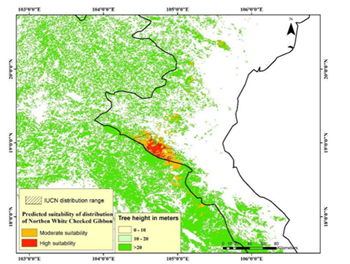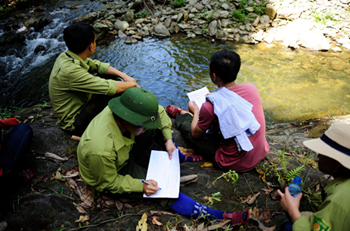Perth Zoo is home to two species of gibbon; the critically endangerd White-cheeked Gibbon and endangered Javan Gibbon.
Sometimes referred to as 'the forgotten ape' these primates are facing increasing threats in the wild due to habitat destruction and the illegal wildlife pet trade.
Perth Zoo is proud to be a global leader in gibbon conservation, working to advocate for the species in the wild and inspire our visitors to make change.
Just this year, the brand-new immersive Gibbon Crossing habitat, a new home for our trio of White-cheeked Gibbons, was launched as part of Perth Zoo's Master Plan.
This innovative habitat is the only one of its kind in Australia and provides opportunity for the agile apes to brachiate (swing) directly above visitors as they enter the Zoo.
The design cleverly uses vertical space to increase the gibbons range and provide them with a safe habitat that closely mimics what they would have in the wild.
The overhead rope pathways stretch more than 170m in length - longer than the oval at Optus Stadium!
Remarkably, with more space to brachiate, Perth Zoo's primate teams have observed new patterns of movement that hadn't been seen from this group of gibbons before.
The Gibbon Crossing has proven to be a popular attraction for Zoo-goers, with more than 70,000 visits coming across the recent spring school holidays.
Perth Zoo runs daily free keeper talks at the Gibbon Crossing, where visitors can learn more and chat to zookeepers about the incredible species.
Conservation partner Fauna & Flora
While primate keepers focus on providing the very best care for the animals here at the Zoo, our work and committment to gibbons extends far beyond our gates here in South Perth.
For nearly 10 years, Perth Zoo has been proudly partnered with Fauna & Flora Vietnam, supporting critical field work in Pu Mat National Park to protect the largest wild population of White-cheeked Gibbons from poachers and wildlife traffickers.
The Zoo specifically supports projects that monitor the gibbon populations and remove threats to wildlife in the area; including:
Habitat modelling
Habitat modelling is very important for conservation work. It helps identify the lay of the land and predict whether areas have suitable biodiversity and ecosystems for a particular species.
Building on existing datasets, Fauna & Flora carried out a comprehensive habitat suitability modelling study for Northern White-Cheeked Gibbon populations. Using Geographic Information Systems and remote sensing data, the team mapped current habitat conditions and model habitat suitability based on the ecosystems.
This modelling activity predicted a strong likelihood of suitable white-cheeked gibbon habitat in the region. It found nearly 500km2 of suitable habitat and an estimated 2,200km2 of moderately suitable habitat!

Capacity building
Fauna & Flora have been upskilling their rangers and local community conservation team members, with specialised training on:
- Gibbon identification
- Accoustic and visual monitoring techniques
- Systematic data collection
This upskilling ensures better long-term monitoring of the population of Northern White-cheeked Gibbons in Pu Mat National Park.
Taking a species-focused approach
Rather than doing general forest patrols and broad threat monitoring, there's been a shift towards a species-focused approach in Pu Mat National Park.
Efforts are centred on the Nothern White-cheeked Gibbon to ensure all activity is targeted and can have maximum impact.
With this change, rangers have patrolled more than 20,345 square kilometres of forest and had 11 different sightings of 10 different gibbon groups. Plus, 116 beautiful gibbon songs have been recorded in the last 60 audio surveys.
This data collection is invaluable!
Local community engagement
We all know conservation starts with people. With targeted education programs and livelihood imitiatives, Fauna & Flora have increased community awareness and participation in conservation activity!
The team have carried out interactive education sessions with children, and even collaborated with government and local communities to run a targeted snare removal campaign.

Heartbreakingly, gibbons are prolific on the illegal pet trade and wild populations are struggling, making this work more important than ever.
From here in Perth, you can help make a change simply by being a responsible social media user, and avoiding or reporting content that showcase wild animals being kept as pets. High online engagement can fuel the illegal wildlife trade and puts increasing pressure on declining populations.
Check out our helpful social media tips to consider here.
Fast facts:
-
White-cheek Gibbons are born with a whitish coat which turns black over their first two years of life. When they reach sexual maturity, males remain black, but females change to a golden colour.
-
They are a small ape species, not a monkey
-
Perth Zoo takes a leading role in the regional breeding program for both species, coordinating the breeding pairs and social groups for all White-cheeked Gibbons in zoos in Australasia and for Javan Gibbons in zoos around the world.